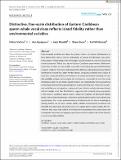Files in this item
Distinctive, fine‐scale distribution of Eastern Caribbean sperm whale vocal clans reflects island fidelity rather than environmental variables
Item metadata
| dc.contributor.author | Vachon, Felicia | |
| dc.contributor.author | Eguiguren, Ana | |
| dc.contributor.author | Rendell, Luke | |
| dc.contributor.author | Gero, Shane | |
| dc.contributor.author | Whitehead, Hal | |
| dc.date.accessioned | 2022-11-07T11:30:20Z | |
| dc.date.available | 2022-11-07T11:30:20Z | |
| dc.date.issued | 2022-11-03 | |
| dc.identifier | 282005567 | |
| dc.identifier | f5dcca23-a7ba-439c-b707-7a4c770996da | |
| dc.identifier | 85142874006 | |
| dc.identifier | 000878155100001 | |
| dc.identifier.citation | Vachon , F , Eguiguren , A , Rendell , L , Gero , S & Whitehead , H 2022 , ' Distinctive, fine‐scale distribution of Eastern Caribbean sperm whale vocal clans reflects island fidelity rather than environmental variables ' , Ecology and Evolution , vol. 12 , no. 11 , e9449 . https://doi.org/10.1002/ece3.9449 | en |
| dc.identifier.issn | 2045-7758 | |
| dc.identifier.other | Jisc: 699946 | |
| dc.identifier.other | publisher-id: ece39449 | |
| dc.identifier.other | society-id: ece-2022-08-01180.r1 | |
| dc.identifier.other | ORCID: /0000-0002-1121-9142/work/122216077 | |
| dc.identifier.uri | https://hdl.handle.net/10023/26311 | |
| dc.description | Funding: This research would not have been possible without support from our partners: CARIMAM and the University of the West Indies, and funders: the National Geographic Society (NGS-62320R-19-2), the AGOA Sanctuary, the Natural Sciences and Engineering Research Council of Canada (NSERC), and the Animal Behavior Society. | en |
| dc.description.abstract | Environmental variables are often the primary drivers of species' distributions as they define their niche. However, individuals, or groups of individuals, may sometimes adopt a limited range within this larger suitable habitat as a result of social and cultural processes. This is the case for Eastern Caribbean sperm whales. While environmental variables are reasonably successful in describing the general distribution of sperm whales in the region, individuals from different cultural groups have distinct distributions around the Lesser Antilles islands. Using data collected over 2 years of dedicated surveys in the Eastern Caribbean, we conducted habitat modeling and habitat suitability analyses to investigate the mechanisms responsible for such fine‐scale distribution patterns. Vocal clan‐specific models were dramatically more successful at predicting distribution than general species models, showing how a failure to incorporate social factors can impede accurate predictions. Habitat variation between islands did not explain vocal clan distributions, suggesting that cultural group segregation in the Eastern Caribbean sperm whale is driven by traditions of site/island fidelity (most likely maintained through conformism and homophily) rather than habitat type specialization. Our results provide evidence for the key role of cultural knowledge in shaping habitat use of sperm whales within suitable environmental conditions and highlight the importance of cultural factors in shaping sperm whale ecology. We recommend that social and cultural information be incorporated into conservation and management as culture can segregate populations on fine spatial scales in the absence of environmental variability. | |
| dc.format.extent | 13 | |
| dc.format.extent | 3902484 | |
| dc.language.iso | eng | |
| dc.relation.ispartof | Ecology and Evolution | en |
| dc.subject | Caribbean | en |
| dc.subject | Cetacean | en |
| dc.subject | Conservation | en |
| dc.subject | Culture | en |
| dc.subject | Habitat modeling | en |
| dc.subject | Site fidelity | en |
| dc.subject | Sperm whale | en |
| dc.subject | GC Oceanography | en |
| dc.subject | QL Zoology | en |
| dc.subject | DAS | en |
| dc.subject | MCC | en |
| dc.subject.lcc | GC | en |
| dc.subject.lcc | QL | en |
| dc.title | Distinctive, fine‐scale distribution of Eastern Caribbean sperm whale vocal clans reflects island fidelity rather than environmental variables | en |
| dc.type | Journal article | en |
| dc.contributor.institution | University of St Andrews. School of Biology | en |
| dc.contributor.institution | University of St Andrews. Centre for Social Learning & Cognitive Evolution | en |
| dc.contributor.institution | University of St Andrews. Centre for Biological Diversity | en |
| dc.contributor.institution | University of St Andrews. Sea Mammal Research Unit | en |
| dc.contributor.institution | University of St Andrews. Institute of Behavioural and Neural Sciences | en |
| dc.contributor.institution | University of St Andrews. Bioacoustics group | en |
| dc.contributor.institution | University of St Andrews. Marine Alliance for Science & Technology Scotland | en |
| dc.identifier.doi | https://doi.org/10.1002/ece3.9449 | |
| dc.description.status | Peer reviewed | en |
This item appears in the following Collection(s)
Items in the St Andrews Research Repository are protected by copyright, with all rights reserved, unless otherwise indicated.

